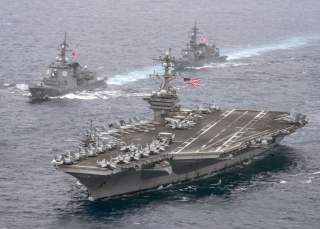China Is Rapidly Closing The Naval Gap With Japan
What does this mean for Asia? And America?
Key point: The Japanese Navy's ability to rapidly sortie the fleet with virtually no notice was perhaps the true test of the MSDF’s professionalism and efficiency.
The best navy in Asia has a total of 114 warships and 45,800 volunteer personnel. It has a large fleet of fast, powerful destroyers, thoroughly modern diesel-electric attack submarines, and amphibious ships that can haul tanks and other ground forces. It can hunt submarines, square off against invasion fleets, and shoot down enemy ballistic missiles. Despite all of that firepower, this is not in fact a navy at all, but an armed cohort of civil servants.
Technically, the Japan Maritime Self-Defense Force is a “self-defense force” designed to overcome the country’s constitutional limits on armed forces. It is, ship for ship, the best navy in Asia.
The main component of the MSDF are its fleet of forty-six destroyers and frigates—more than that those fielded by the United Kingdom and France combined. Organized into escort flotillas, Japan’s tin-can navy is designed to defend the country from invasion, help retake Japanese territory and keep the sea-lanes open.
The most powerful of Japan’s surface combatants are the Kongo class of guided-missile destroyers. The four ships—Kongo, Kirishima, Myoko and Chokai—are all named after battleships and cruisers of the Imperial Japanese Navy, a practice once generally avoided but becoming more popular as the memory of World War II fades.
The Kongo destroyers are based on the original U.S. Navy Arleigh Burke–class Flight I destroyers in general shape and armament. Like the Burke class, the heart of the ship is the Aegis Combat System, capable of tracking and engaging area air-defense threats. It also provides a national ballistic-missile defense system for all of Japan—just two Kongos can protect most of the country.
Armament for the destroyers is primarily defensive, with ninety Mark 41 vertical launching missile silos, split between the fore and aft decks. The Kongos carry SM-2MR air defense missiles and SM-3 Block IB ballistic missile interceptors, the latter soon to be replaced with the newer Block IIA version. The destroyers also carry one five-inch main gun, eight Harpoon antiship missiles, six antisubmarine torpedo tubes and two twenty-millimeter Phalanx close-in weapon systems.
Another formidable Japanese ship is the JS Izumo. At twenty-seven thousand tons fully loaded and more than eight hundred feet long, Izumo has a full-length flight deck, an island for controlling flight operations, aircraft elevators and a hangar that spans the length of the ship.
While that sounds like a traditional aircraft carrier, Japan insists the ship is actually a “helicopter destroyer.” Izumo can’t carry fixed-wing fighter jets but it can carry up to fourteen helicopters. These helicopters and their missions can vary, from antisubmarine warfare to minesweeping to helicopter airmobile assault. This makes the Izumo a flexible platform capable of taking on a variety of tasks. A second ship of the class, Kaga, is currently under construction.
Japan’s submarine force is another major component of the MSDF. Japan is building up to a force of twenty-two submarines to provide great numbers against a growing Chinese Navy. The fleet will consist of two classes of submarines, the older Oyashio class, and the newer, deadlier Soryu class.
At 4,100 tons submerged, the Soryu submarines are Japan’s largest submarines since the I-400 class of World War II. The subs are equipped with Stirling air independent propulsion systems, capable of powering the submarine silently underwater for up to two weeks, and can make thirteen knots surfaced and twenty knots submerged.
The Soryus are equipped with six 533-millimeter bow-mounted torpedo tubes, with a mix of twenty Type 89 heavyweight homing torpedoes and American-made Sub-Harpoon missiles. They can also lay mines to block the many straits an invasion force would attempt to force.
Finally, Japan has three Osumi-class tank landing ships. The ships resemble small aircraft carriers, with a 130-meter long flight deck stretching the length of the ship. That’s where the resemblance ends, however, as the Osumi ships lack aircraft elevators and a hangar. The ships were designed to rapidly move Ground Self-Defense Force tanks between the main islands of Japan, reinforcing any of them against invasion.
The Osumis can carry up to 1,400 tons of cargo, fourteen Type 10 or Type 90 tanks, and up to one thousand ground troops. They are equipped with well decks and American-designed LCAC hovercraft, allowing them to float out heavy equipment and sent them to shore. This capability is especially useful in light of Japan’s new dynamic defense strategy, which calls for amphibious forces capable of taking back islands seized by a hypothetical enemy.
One final reason why Japan’s navy is the best in Asia? On March 11, 2011, a magnitude 9.0 earthquake struck off the coast of northern Japan. Vice Admiral Hiromi Takashima, commandant of the Yokosuka Naval District, immediately assumed temporary command of the entire MSDF and ordered all available ships north to the earthquake zone. The first ship left just forty-five minutes after the earthquake. Another seventeen ships packed with relief supplies departed within eighteen hours, some with only partially recalled crews. This ability to rapidly sortie the fleet with virtually no notice was perhaps the true test of the MSDF’s professionalism and efficiency.
Kyle Mizokami is a defense and national security writer based in San Francisco who has appeared in the Diplomat, Foreign Policy, War is Boring and the Daily Beast. In 2009 he cofounded the defense and security blog Japan Security Watch. You can follow him on Twitter: @KyleMizokami. This first appeared in 2016.
Image: Flickr.

